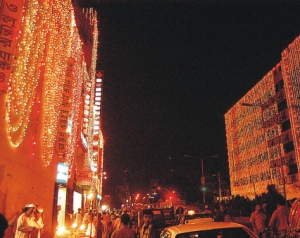|
News
Dead: 40,000
in Pakistan and India quake
 Horror struck the Pakistan-India border when some 40,000 people were killed in a 7.6 magnitude earthquake on October 8, with the rising death toll feared at over 40,000. The number of injured is estimated at 60,000 with two-and-a-half million rendered homeless. Horror struck the Pakistan-India border when some 40,000 people were killed in a 7.6 magnitude earthquake on October 8, with the rising death toll feared at over 40,000. The number of injured is estimated at 60,000 with two-and-a-half million rendered homeless.
Of them, at least 1,000 were students about to start classes when the quake struck just after 8:50 am. At least 250 of them were schoolgirls, killed when their school in northwestern Pakistan collapsed in what was reportedly the strongest quake in the last 100 years. Hundreds of students remain trapped under the rubble of their collapsed schools, some still alive and pleading to be rescued, others silent . . .
At least 200 soldiers were also killed in Pakistani Kashmir. Homes, hospitals and schools have collapsed. Rescue work continues in the cold, mountainous areas, hindered in some areas by the poor communication links while other areas are impassable. Those lucky to still find themselves alive, try to brave the cold and hunger inevitable for the survivors, their homes, possessions and loved ones lost in mass graves.
India, where casualties have been reported in the hundreds, has offered assistance and condolences to neighbour and long-time rival Pakistan, while Pakistani president Pervez Musharraf has appealed for international assistance, declaring the disaster as one his country cannot handle alone. Some four have died in Afghanistan while Bangladesh also felt the quake but no casualties or damages were reported.
Iraq WMD inspector wins Nobel award
The 2005 Nobel Peace Prize was finally awarded to Mohamed El Baradei and the International Atomic Energy Agency, amid some controversy. El Baradei beat both Bob Geldof and Bono, the U2 singer, who many expected would be rewarded for their work on Live 8 and third world debt relief, to claim the world's most prestigious humanitarian award.
As director of the IAEA, which is charged with preventing nuclear proliferation, El Baradei had repeatedly clashed with Britain and the United States over the invasion of Iraq and the treatment of Iran and North Korea. However, the Nobel Committee used the 60th anniversary of the bombing of Hiroshima and Nagasaki to highlight the peril of nuclear weapons and to further encourage steps towards their abolition. The award was praised by Japanese survivors from both bombed cities.
The committee's statement read: "At a time when disarmament efforts appear deadlocked, when there is a danger that nuclear arms will spread both to states and to terrorist groups, and when nuclear power again appears to be playing an increasingly significant role, IAEA's work is of incalculable importance."
El Baradei said the $1.3 million Nobel award would give him and his agency a much needed "shot in the arm" as they tackle the nuclear crises in Iran and North Korea.
The Egyptian diplomat said he had been sure he would not win because he had not received the traditional advance telephone call from the Committee. He learnt of his win at home while watching television with his wife, Aida. He said he jumped to his feet then hugged and kissed her in celebration.
 The power is yours! The power is yours!
As a solution to the recent load-shedding problem, various shop owners in the Dhaka metropolitan area have decided to stop illuminating their shopping malls, as per the request by the Prime Minister to cut down on electricity consumption. According to the president of the Dhaka Metropolitan Shop Owners Association (DMSOA), M Helaluddin, the shop owners have decided to save the electricity rather than carry on with the tradition of illuminating their stores to attract more customers in the month of Ramadan.
At a meeting held last week, the leaders of the association assured the State Minister for Home Affairs Lutfozzaman Babar that the lighting would stop.
The ones who had attended the meeting are already carrying out their commitment, that is, of not switching off the lights and thus saving electricity. "We hope, the rest will do so soon as well," said Helaluddin.
ICS hopes dashed by BCL
 |
| Bangladesh Chhatra League men chase activists of Islami Chhatra Shibir, student wing of ruling coalition partner Jamaat-e-Islami, near Dhaka Medical College |
As activist of Islami Chharta Shibir (ICS) in an unprecedented move came out in public for the first time to distribute invitation cards among students and teachers for an iftar party, some Bangladesh Chhatra League (BCL) members intervened. They went to resist them at the main gate of Arts Building at around 11.45 am on October 9. A violent clash erupted that turned the entire arts Faculty area into a virtual battleground.
The ICS cadres were chased out of the campus by the BCL activists, and they took shelter at the Mall Chattar. From there they were trying to bring out a procession in protest of the BCL attack. As soon as ICS men chanted slogans, the BCL men, armed with bamboo sticks, launched a second attack. The ICS, then, chanted slogans in the name of Jatiyatabadi Chhatra Dal, (JCD) and retaliated. The ICS activists however had to back out in the face of the mightier BCL power. The clash however saw 10 ICS and two BCL activists injured. Police presence was increased following the clash.
ICS is an outfit that mostly relies on clandestine activities to advance their causes. In Dhaka University their activities are usually kept under wrap. On October 9, they chose to carry out their agenda out in the open. But BCL men dashed the hopes of the activists of ICS to follow a new course.
Copyright
(R) thedailystar.net 2005
|
| |
